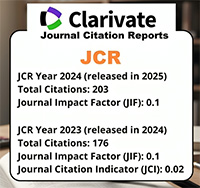La eficacia de los aceites ozonizados en el tratamiento de pacientes con micosis superficiales.
The efficacy of ozonated oils in the treatment of patients with superficial mycosis.
Abstract
Superficial mycoses are one of the main reasons for consultation in the dermatological area. In recent years, the therapeutic effectiveness of ozonated oils in fungal infections has been verified in different countries due to its broad germicidal and antifungal spectrum. The objective is to evaluate the efficacy of the use of ozonated sunflower oil in the treatment of superficial mycoses in patients of the Mycology consultation at the Dermatology Service of the Hospital Vargas de Caracas, Instituto Autonómo de Biomedicina “Dr. Jacinto Convit”. A cross-sectional descriptive, experimental study was conducted, where 36 patients diagnosed with superficial mycosis and ten healthy subjects were evaluated. Of the group of 36 patients, 26 were treated with ozonated sun-flower oil (AGO) and ten patients with non-ozonized sunflower oil (AGNO). Ten healthy individuals represented the AGO sensitivity control. The most frequent superficial mycosis evaluated in the AGO group was tinea corporis (31%), fol-lowed by denture stomatitis (23%) and for the AGNO group, tinea pedis (50%). Regarding the etiological agent, an improvement with the AGO treatment of 86% for Candida albicans and 60% for the Trichophyton rubrum complex was evidenced at week eight of treatment. It is concluded that the antifungal effect of AGO is more significant for the genus Candida spp than for dermatophytes, evidencing a total improvement of the lesions with six weeks of treatment.
Downloads
References
Chiacchio N, Madeira C, Humaire C, Silva C.S, Gomes Fernandes L, Dos Reis Superficial mycoses at the Hospital do Servidor Público Municipal de São Paulo between 2005 and 2011. An Bras Dermatol 2014; 89:67-71. doi: 10.1590/abd1806-4841.20141783.
Havlickova Blanka, Czaika Viktor, Friedrich Markus. Epidemiological trends in skin mycoses worldwide. Mycoses 2008;51 Suppl 4:2-15. doi: 10.1111/j.1439-0507. 2008.01606.x.
Das Saibal, Bandyopadhyay Sanjib, Sawant Sanket Chaudhuri S. The epidemiological and mycological profile of superficial mycoses in India from 2015 to 2021: A systematic review. Indian J Public Health 2023;67(1):123-135. doi: 10.4103/ijph.ijph_987_22.
Sharma Bharti, Nonzom Skarma. Superficial mycoses, a matter of concern: Global and Indian scenario an updated analysis. Mycoses 2021; 64(8):890-908. doi: 10.1111/myc.13264.
Schwartz A, Kontorchnikova C, Malesnikov O, Martínez-Sánchez G. Guía para el uso médico del ozono: fundamentos terapéuticos e indicaciones. Vol 1. 1ra ed. Madrid: Asociación Española de Profesionales Médicos en Ozonoterapia. AEPROMO; 2011.
Menéndez S, Falcón L, Simón D, Landa N. Efficacy of ozonized sunflower oil in the treatment of tinea pedis. Mycoses 2002; 45(8):329-332. doi: 10.1046/j.1439-0507.2002.00780.x.
Tartari AP, Moreira FF, Pereira MC, Carraro E, Cidral-Filho FJ , Inoue Salgado A, Ilvan Kerppers I. Anti-inflammatory effect of ozone therapy in an experimental model of rheumatoid arthritis. Inflammation 2020; 43:985–993. doi: 10.1007/ s10753-020-01184-2.
Rodríguez ZB, Álvarez RG, Guanche D, Merino N, Hernández Rosales F, Menéndez Cepero S, González Y, Schulz S. Antioxidant mechanism is involved in the gastroprotective effects of ozonized sunflower oil in ethanol-induced ulcers in rats. Mediators Inflamm 2007; 2007:65873. doi: 10.1155/2007/65873.
Urbano Machado A, Vidor Contri R. Effectiveness and safety of ozone therapy for dermatological disorders: a literature review of clinical trials. Indian J Dermatol. 2022; 67(4): 479. doi: 10.4103/ijd.ijd_152_22.
Camacaro L, De Arbeloa M, Fernández A, Cavallera E, Alvarado P. PCR multiplex en la detección de Tinea unguium en pacientes de Caracas –Venezuela. Invest Clin 2019; 60 (2): 160-170. doi.org/10.22209/ IC.v60n2a05.
Bocci V. Ozone. A New Medical Drug. 2da ed. Italia: Springer editors; 2011. p.227- 237.
Güner M, Görgülü T, Olgun A, Torun M, Kargi E. Effects of ozone gas on skin flaps viability in rats: an experimental study. J Plast Surg Hand Surg 2016; 50:291-297. doi: 10.3109/2000656X.2016.1170024.
Clavo B, Santana-Rodriguez N, Llontop P, Gutiérrez D, Ceballos D, Charlin Méndez C, Rovira G, Suarez G, Rey-Baltar D, García L, Martínez-Sánchez G, Fiuza D. Ozone therapy in the management of persistent radiation-induced rectal bleeding in prostate cancer patients. J Evid Based Complementary Altern Med 2015; 2015:1-7. doi: 10.1155/2015/480369.
Sechi LA, Lezcano I, Nunez N, Espim M, Duprè I, Pinna A, Molicotti P, Fadda G, Zanetti S. Antibacterial activity of ozonized sunflower oil (Oleozon) J Appl Micro-biol 2001;90(2):279-284. doi: 10.1046/ j.1365-2672.2001.01235. x.
Arenas R, Bonifaz A, Padilla M, Arce M, Atoche C, Barba J, Campos P, Fernández R, Mayorga J, Nazar D, Ocampo J. Onychomycosis. A Mexican survey Eur J Dermatol 2010;20(5):611-4. doi: 10.1684/ ejd.2010.1023.
Weitzman I, Summerbell R. The dermatophytes. Clin Microbiol Rev 1995; 8:240–259. doi: 10.1128/CMR.8.2.240.
Tangarife C, Verónica J, Flórez M, Sindy V, Mesa Arango, Ana C. Diagnóstico micológico: de los métodos convencionales a los moleculares. Med Lab 2015; 21: 211-242. doi.org/10.36384/issn.0123-2576.
Arosemena R, Halmai O, González M. Estudio prospectivo de pacientes con tinea pedis de la consulta de micología durante el segundo trimestre de 1989. Dermat Venez 1990; 28:65-67.
Angulo A, Bravo N, Falco A, Pulido A, Rivera Z, Cavallera E. Dermatofitosis por Trichophyton rubrum. Experiencia de 10 años en el Departamento de Micología del Instituto de Biomedicina. Dermat Venez 2008; 46:12-17.
Travagli V, Zanardi I, Valacchi G, Bocci V. Ozone and ozonated oils in skin diseases: a review. Hind Publish Corp. Med Inflam 2010; 2010:1-9. doi: 10.1155/2010/610418.
Kumar T, Arora N, Puri G, Aravinda K, Dixit A, Jatti D. Efficacy of ozonized olive oil in the management of oral lesions and conditions: A clinical trial. Contemp Clin Dent 2016; 7:51-54. doi: 10.4103/0976- 237X.177097.
Ouf S, Moussa T, Abd-Elmegeed A, Eltahlawy S. Anti-fungal potential of ozone against some dermatophytes. Braz J Microbiol 2016; 47: 697-702. doi: 10.1016/j. bjm.2016.04.014.
Thomson P, Anticevic S, Rodríguez H, Silva V. Actividad antifúngica y perfil de seguridad del producto natural derivado del aceite de maravilla ozonizado (AMO3) en dermatofitos. Rev Chil Infect 2011; 28:512-519.
Weitzman I, Summerbell R. The dermatophytes. Clin Microbiol Rev 1995; 8:240–259. doi: 10.1128/CMR.8.2.240.
Geweely N. Antifungal activity of ozonized olive oil (Oleozone). Int J Agri Biol 2006;8: 671-678. doi: 1560–8530/2006/08–5–670–675.
Menéndez S, Falcón L, Maqueira Y. Therapeutic efficacy of topical OLEOZON® in patients suffering from onychomycosis. Mycoses 2011;54(5):e272-7. doi: 10.1111/ j.1439-0507.2010.01898.x





















